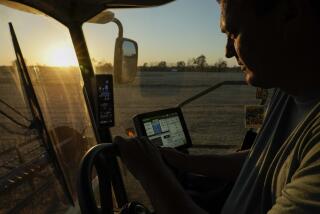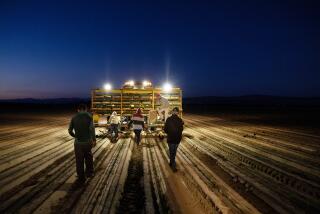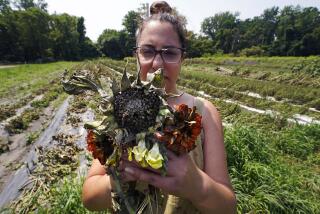Little Federal Aid in Store for Dixie Farmers
COPE, S.C. — Big, beefy Edd Bonnette reared back in a chair in the wood-paneled kitchen of his farmhouse and recalled, with ironic delight, the good old days of the droughts of ’77 and ’81.
“Back then, if you was a farmer in trouble, it seemed the federal government couldn’t throw enough money at you,” said Bonnette, 51, a third-generation farmer with 1,800 acres here in Orangeburg County. “I got a $315,000 disaster loan in 1977 and another one for $225,000 in 1981. Both of them really helped me to build up this place.”
Well Running Dry
This year, in contrast, as Bonnette and other Southeastern farmers devastated by the worst drought in more than a century are painfully learning, the federal well is likely to come up pretty dry itself.
Despite the promises of aid that Washington made to farmers in the heat of the summer, now, as federal budget deficits continue to climb, fiscal austerity is the watchword. The days of generous bail-outs and liberal loans for disaster assistance appear to be gone with the wind.
“With the Gramm-Rudman deficit reduction act as the guide to spending, farm programs are prime targets because of the enormous amount of money shelled out in the past,” said Gene Marsh, a University of Alabama specialist in agricultural economics and law. “The federal government is not going to be anywhere near as good-hearted to drought-stricken farmers this year as it was before.”
That is especially bad news for the many financially overextended farmers who desperately needed--but did not get--a good 1986 harvest to help pull them through the worst economic slump in agriculture since the Great Depression. It is certain to spell the end of farming for some of them, particularly those with row crops rather than livestock.
In Alabama, for instance, agricultural officials estimate that the state may lose 10% of its farmers as a result of this year’s weather. The long Southern drought, which was compounded by a record heat wave that often sent temperatures over the 100-degree mark for days on end, seared a nearly $2-billion path of destruction through an arc of states from Louisiana upward to Virginia.
Rainfall was off as much as 60% in some areas, decimating crops, parching pasturelands and shrinking irrigation ponds. Even now, as farmers get ready to plant their winter grazing, many areas are still not getting enough rain.
$815 Million in Losses
In three of the hardest-hit states--Georgia, South Carolina and North Carolina--the combined drought losses will total more than $815 million after all the bills are in, according to a joint study by the University of Georgia, Clemson University and the University of North Carolina. That figure represents a 15% cut in the total anticipated farm income this year for the three states.
During the summer, President Reagan made repeated pledges to aid drought-stricken areas. At a campaign stop in Columbia, S.C. in late July, for instance, he said: “The drought is reaching tragic proportions--one of the worst in the century--and I want you to know that our Administration stands ready to help.”
But when the Administration aid package was announced on Aug. 1 by Agriculture Secretary Richard E. Lyng, farmers were less than impressed. One key item--a 10% increase in the advances on subsidies due row-crop farmers this year--was widely denounced as next to useless.
“It hardly amounted to anything for the individual farmer,” said Hal Harris, a Clemson agricultural economist. “Besides, to say that it was a drought-relief measure is stretching the imagination, because farmers in the Midwest who had bumper crops were eligible for it too.”
‘Hot Lines’ Assailed
In one sign of the often vociferous political wrangling over drought aid, Sen. Ernest F. Hollings (D-S.C.) and South Carolina’s three Democratic congressmen--all of whom were up for reelection this year--accused the Administration of providing little more than “task forces and hot lines” to combat the problem.
On Capitol Hill, a House-approved drought-relief measure would have authorized $530 million in aid, but it was never considered by the Senate. Similar provisions were later attached to a Senate proposal to raise the federal debt ceiling. The debt measure died, however, after disagreements between the House and Senate on unrelated issues.
Federal crop insurance, whose premiums farmers pay for out of their own pockets, will help offset the drought losses of some producers. Farmers in Georgia and the Carolinas, for example, are expected to collect an aggregate of about $90 million in crop indemnity payments for the toll in their wheat, corn, cotton, soybeans and other row crops, according to agricultural extension specialists.
Feed Assistance
In addition, as a result of emergency federal feed assistance programs authorized by laws already on the books but implemented under the Administration package, many dairy farmers and livestock producers will continue to get help through the winter and will not be forced to sell off large parts of their herds in order to make ends meet. They also are getting a much-appreciated helping hand from a voluntary haylift, organized by Midwestern farmers this summer and still going on.
But the centerpiece of the federal government’s drought-relief efforts--a $400-million disaster aid package approved by Congress in late October as part of the omnibus spending bill for the 1987 fiscal year--is not going to stretch very far and probably will not be of much aid to those worst off, Southeastern farmers and agricultural officials say.
“They appropriated $400 million and just over in Georgia, I hear the farmers lost around $350 million this year,” Bonnette said. “Plus, the farmers in the Southeast have to share the money with the farmers in the Midwest who got flooded out. What the individual farmer like me is going to wind up with will be just a drop in the bucket compared to his needs.”
Loan Window Closed
Even worse, when farmers begin lining up at federal lending institutions for low-cost disaster relief loans to help them get started on the new growing season, they are much more apt to find the window closed in their face.
“Disaster loans are going to be much harder to get this year because there is only going to be so much money in the pot and because so many previous disaster loans have turned sour,” said Clemson University’s Harris.
Some of the previous loans also were misused. “A lot of farmers just used the money to buy fancy pickups or expensive new farm equipment they didn’t really need,” Harris said.
Private agricultural lenders, who might ordinarily be expected to provide a helping hand, will be even more Scrooge-like--and for much the same reasons.
Cites ‘Bad Loans’
Lynn Z. Dantzler, president of the Edisto Federal Land Bank Assn., which serves a 12-county region around Orangeburg County, said that 15% of the $200 million in his bank’s outstanding loans are now listed as “bad loans.”
“We’ll be taking a much closer look at ability to repay,” Dantzler said. “From our standpoint, anyone with a debt-to-equity ratio of more than 50% is going to have a real hard time generating an adequate cash flow. And that includes a lot of farmers.”
A Clemson University study, for example, showed last year that more than 19% of South Carolina’s farmers fell into the “severely distressed” financial category, meaning that they had a debt-to-equity ratio of 40% or more.
In Georgia, state agricultural department spokesman Steve Rich says that about 1,000 farmers a year have been going out of business over the last two years and, with the 1986 drought apparently accelerating the trend, “there could be at least another 1,000 this year.”
Here in Orangeburg County, one of South Carolina’s leading agricultural regions, the picture is even bleaker.
‘Barely Treading Water’
“I’d say probably 20% of the farmers in this county are likely to go under,” said Charles W. Davis Jr., the county agricultural extension agent. “But the other 80% aren’t doing all that well by any means. Some of them are just barely treading water.”
To make matters worse, the “ripple effect” from these anticipated farm failures is certain to deepen the financial problems on rural Main Street among farm equipment dealers, fertilizer stores and local agricultural banks, just as it has already done across the Midwest.
“I’m already in the process of trying to get rid of my business,” said Carlisle Kinard of Denmark, S.C., who has been a John Deere equipment dealer for nearly a quarter-century. “I was hurt bad. I farm a little, also. But I can’t live off that. With poor prices, everything went against the farmer this year.”
Edd Bonnette, who got so much federal aid after earlier droughts, typifies the stricken farmers for whom federal protection will fall far short this year.
Endangered Species
As a row-crop farmer--a highly endangered species in agriculture--he was in deep financial trouble even before summer baked his land. Expenses were rising, profits were declining and his debts had risen to more than $500,000--much of it made up of the disaster relief loans he had received from the Small Business Administration in 1977 and 1981.
This year, the bottom fell out. The drought claimed his entire wheat crop, slashed his cotton crop by two-thirds and cut his corn crop in half. “I probably lost just on corn at least $30,000--and maybe more than that,” he said.
He predicts an even bigger loss from his soybeans, which are a late crop in this region and are just beginning to be harvested or “pulled,” as farmers say.
During the summer his creditors repossessed a tractor and two combines after he failed to meet even part of the $78,000 back payments. And he recently received a letter from a local agricultural bank notifying him well in advance that a $37,000 payment will be due in December.
Only Cotton Insured
Like many Southeastern farmers, he has federal crop insurance on his cotton, cotton being high in both production costs and in market value. But he has insured no other crop. Typically, according to agricultural extension specialists, this program reimburses farmers for 80% to 90% of their lost production costs.
As for the rest, he says, his losses will far surpass his share of the $400-million federal disaster relief package, the only direct federal aid for drought-stricken Southeastern row-crop farmers. What is more, with so many shaky loans already on the books, Bonnette doubts that he will be able to borrow enough to get through another growing season.
“I’m not going to sit here and tell you a lie--I’m staring bankruptcy dead in the face,” he said.
“I’m trying to sell off some land to get some cash. But if that fails, my only hope is that I can work something out with my creditors so that I don’t lose everything and can keep on farming in some way.”
Tough Hoeing
Even many row-crop farmers in a healthier financial condition are finding the hoeing tough. “The row-crop farmer is finding it harder and harder to pencil in a profit,” said Johnny Gramling, 54, who farms 2,500 acres near Orangeburg, the county seat. “We basically haven’t made anything over the last three to four years. Soybeans are selling for $4 to $5 a bushel and it costs you $6.50 to $7 a bushel to grow them. If the government wants to do something, it ought to do something about the prices we’re getting for our products.”
By contrast, dairy cattlemen and livestock producers were better able to weather this year’s drought. Although it is largely viewed as a morale booster, the voluntary haylift from Midwestern farmers provided a much-needed shot in the arm, taking care of the needs of some livestock farmers for as much as 10 days at the worst of the drought.
But more important is the federal emergency feed assistance program that reimburses livestock farmers for up to 50% of their feed costs. To qualify, farmers have to have lost at least 50% of their primary feed sources.
Won’t Have to Sell Cows
“It’s going to allow me to keep my brood cow herd up this winter without having to sell half of them just to exist,” said Jan Kennerly, 41, a Swansea, S.C., cattleman and president of the South Carolina Cattlemen’s Assn. “I have a herd of about 50-55 purebreds. Instead of having to pay $300 a head to winter them, it’s only going to cost me half that.”
Still, he says, the drought saw many livestock producers fall by the wayside, and the survivors have learned a great lesson.
“The drought has made better managers out of us all,” he said. “We’ve learned to cut costs to the bone, to cull unproductive animals and to think and act more like businessmen. The days of the Marlboro Man image or the flamboyant Texas cattleman image are over.”
Bankruptcy Plan
One federal measure each drought-stricken Southeastern farmer hopes not to have to use is one that permits small farmers to file for bankruptcy with less danger of losing their farms.
Signed recently by President Reagan, the act creates a new Chapter 12 of the U.S. Bankruptcy Code to be used only by persons whose debts do not exceed $1.5 million and are at least 80% farm-connected. The new bankruptcy law also allows farmers to reorganize debts without having to sell off their farms.
“We still feel like if we can just hold on a little longer, things will get better,” Bonnette said.
Researcher Diana Rector in Atlanta contributed to this report.
More to Read
Sign up for Essential California
The most important California stories and recommendations in your inbox every morning.
You may occasionally receive promotional content from the Los Angeles Times.










